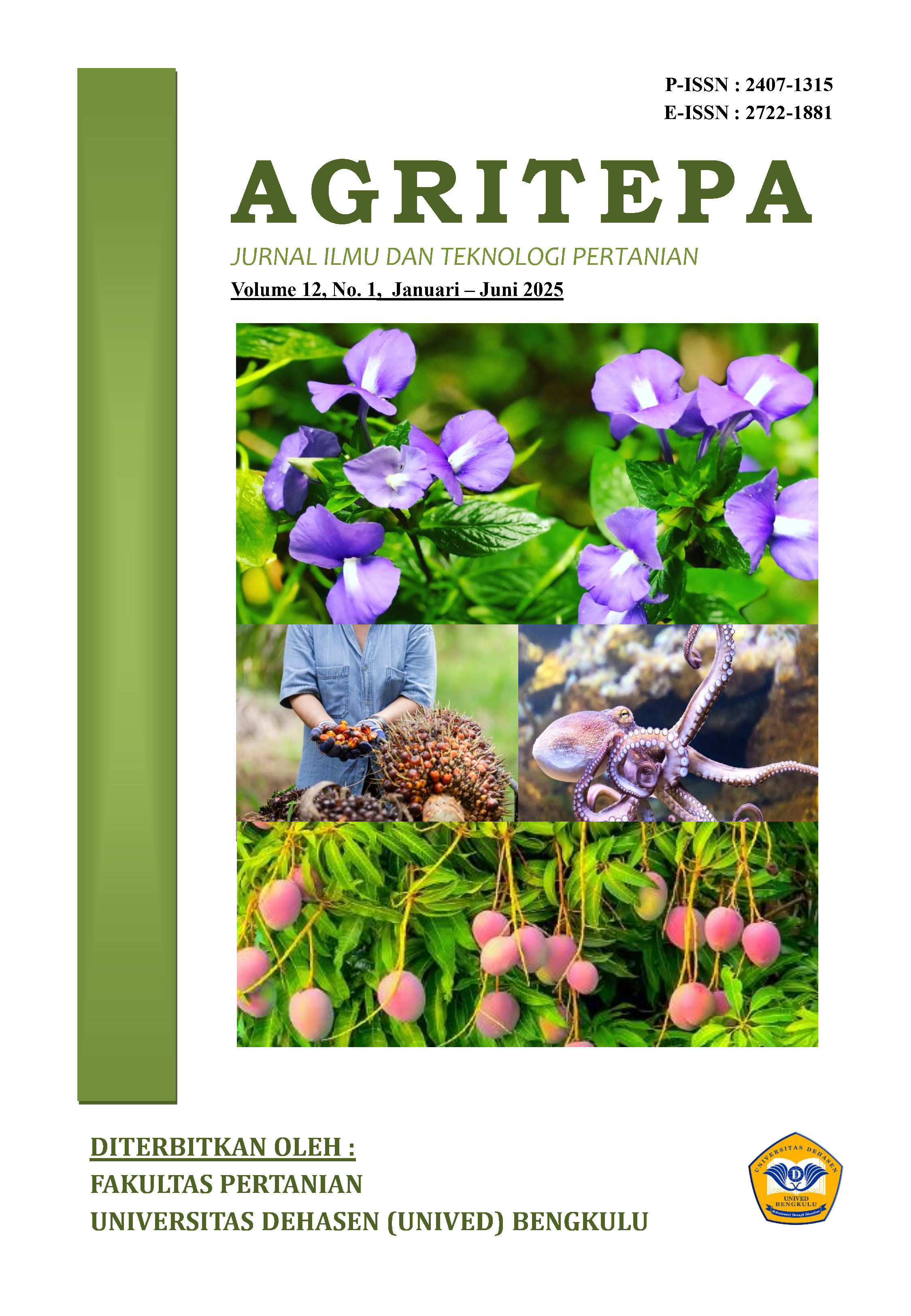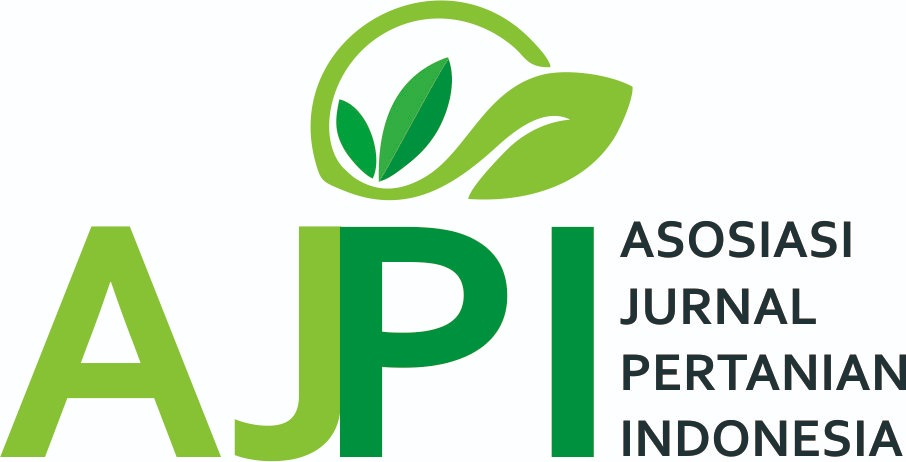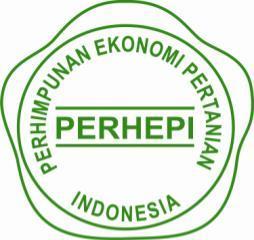The Effect Of Color Variation And Water Appplication On The Effectiveness Of Fruit Flies Traps In Mango Orchards (Mangifera Indica L.)
Abstract
The Purpose: The primary objective of this study is to assess the impact of trap color variation and the presence of water media on enhancing the effectiveness of fruit fly (Bactrocera spp.) capture in the mango orchard (Mangifera indica L.) owned by PT Galasari Gunung Sejahtera. Methodology: The research method employed a factorial Randomized Complete Block Design (RCBD) with two main factors, namely trap color (red, yellow, brown, orange) and the presence of water media (with or without water). Eight treatment combinations were generated, each repeated four times. The parameters analyzed included the number of fruit flies captured during the first and second weeks after the traps were installed. Results: Traps equipped with water media were found to capture significantly more fruit flies compared to traps without water media, in both the first and second weeks. Meanwhile, variations in trap color did not show a significant effect on the number of fruit flies captured. Findings: The presence of water media enhanced the attractiveness of the traps to fruit flies, while trap color was not a major factor in attracting them. Novelty: This study highlights the importance of adding water media to traps as a simple yet effective innovation for controlling fruit flies in mango orchards. Originality: The research provides the latest empirical data on the combined use of water and trap color under real field conditions, an area that remains limited in the local research literature. Conclusion: Traps containing water media are recommended as an effective method to control fruit fly populations in mango orchards, without relying on trap color variations. Article Type: Empirical Research Article.
Downloads
References
Badan Pusat Statistik. (2022). Produksi Mangga di Indonesia Tahun 2021. Laporan Statistik Pertanian.
Bateman, M. A. (1972). The Ecology of Fruit Flies. Annual Review of Ecology and Systematics, 3(1), 219–246.
Clarke, A. R., Armstrong, K. F., Carmichael, A. E., Milne, J. R., Raghu, S., Roderick, G. K., & Yeates, D. K. (2005). Invasive Phytophagous Pests Arising Through a Recent Tropical Evolutionary Radiation: The Bactrocera dorsalis
Complex of Fruit Flies. Annual Review of Entomology, 50(1), 293–319.
Dominiak, B. C., & Ekman, J. H. (2013). The Rise and Fall of Control of Fruit Fly (Bactrocera tryoni) in Australia. Crop Protection, 44, 3–9.
Drew, R. A. I., & Romig, M. C. (2013). Tropical Fruit Flies of South-East Asia (Tephritidae: Dacinae). CABI Publishing.
Emilda, D. (2013). Metode Pengendalian Hama dengan Perangkap Feromon. Jurnal Agroteknologi Indonesia, 6(1), 72-79.
Emilda, D., Jumjunidang, R., Hariyanto, B., Muas, I., Sudjijo, & Andini, M. (2013). Aplikasi fungisida kimia untuk pengendalian penyakit busuk batang buah naga. Jurnal Penelitian, 683–689.
IAEA. (2013). Trapping Guidelines for Area-Wide Fruit Fly Programmes. International Atomic Energy Agency.
Indrajati, S.B., Saputra, L.D., & Rosita, D. (2021). Buku Lapang Budidaya Durian. Direktorat Buah dan Florikultura, Direktorat Jenderal Hortikultura.
Koswanudin, H. (2018). Biologi dan Pengendalian Hama Lalat Buah (Bactrocera spp.). Jurnal Entomologi Indonesia, 15(3), 112-120.
Koswanudin, H. (2018). Pengaruh Faktor Lingkungan terhadap Populasi Lalat Buah. Jurnal Ekologi Pertanian, 3(1), 23-35.
Liquido, N. J., McQuate, G. T., & Cunningham, R. T. (2019). Fruit Flies (Tephritidae) and Their Impact on Agriculture. Annual Review of Entomology, 64, 47–65.
Metcalf, R. L. (1990). Chemical Ecology of Dacinae Fruit Flies (Diptera: Tephritidae). Annals of the Entomological Society of America, 83(6), 1017–1030.
Novia, C., Syaiful, & Deni Utomo. (2015). Diversifikasi Mangga off Grade Menjadi Selai dan Dodol. Jurnal Teknologi Pangan, 6(2), 76-79.
Pratiwi, S. (2022). Evaluasi Efektivitas Perangkap Lalat Buah dengan Media Air. Jurnal Agroindustri Tropika, 12(2), 100-110.
Pratiwi, S. N. (2022). Efektivitas Metil Eugenol dalam Menarik Lalat Buah. Jurnal Hama dan Penyakit Tumbuhan Tropika, 8(2), 87-95.
Pratiwi, S. N., Fatimatuzzahra, F., Marniati, H., & Isnawan, Y. (2022). Inventarisasi Hama Lalat Buah (Bactrocera spp.) di SKP Kelas I Bengkulu Wilker Pulau Baai Dengan Perangkap Methyl Eugenol. Organisms: Journal of Biosciences, 2(1), 35-40.
Sahetapy, B. (2019). Strategi Pengendalian Lalat Buah di Tanaman Hortikultura. Jurnal Perlindungan Tanaman, 10(1), 50-60.
Sahetapy, B. (2019). Teknik Pengelolaan Hama Lalat Buah dengan Metode Ramah Lingkungan. Jurnal Teknologi Pertanian Berkelanjutan, 5(1), 19-30.
Sahetapy, B., Riadh U. M., Naibu L. (2019). Identifikasi Lalat Buah (Bactrocera spp.) Asal Tanaman Cabai (Capsicum annuum L.) dan Belimbing (Averrhoa carambola L.) Di Kecamatan Salahutu Kabupaten Maluku Tengah. Jurnal Agrikultura, 30 (2), 63-74.
Susanto, A. (2018). Pengaruh Warna Perangkap terhadap Efektivitas Penangkapan Lalat Buah.
Jurnal Entomologi Terapan, 14(1), 55-63.
Susanto, A. (2018). Peran Atraktan dalam Pengendalian Lalat Buah. Jurnal Proteksi Tanaman Tropika, 9(2), 77-89.
Susanto, A., Natawigena, W. D., Puspasari, L. T., & Atami, N. I. N. (2018). Pengaruh penambahan beberapa esens buah pada perangkap metil eugenol terhadap ketertarikan lalat buah Bactrocera dorsalis kompleks pada pertanaman mangga di Desa Pasirmuncang, Majalengka. Jurnal Perlindungan Tanaman Indonesia, 22(2), 150-
Tan, K. H., & Nishida, R. (2012). Methyl Eugenol: Its Occurrence, Distribution, and Role in Nature Especially in Relation to Insect Behavior and Plant Pollination. Journal of Insect Science, 12(1), 56.
Vargas, R. I., Piñero, J. C., & Leblanc, L. (2015). An Overview of Pest Species of Bactrocera Fruit Flies (Diptera: Tephritidae) and the Integration of Biopesticides With Other Biological Approaches for Their Management. Insects, 6(2), 297–318.
Waryat, W. (2023). Efektivitas Kombinasi Atraktan dan Warna Perangkap dalam Menangkap Lalat Buah. Jurnal Riset Hortikultura, 15(1), 95-110.
Waryat, W., Nurawan, A., Prawiranegara, D., & Hamdani, K. K. (2023). Karakteristik Usahatani Mangga Varietas Gedong Gincu di Kabupaten Cirebon. Agrisintech (Journal of Agribusiness and Agrotechnology), 4(1), 9-18.
White, I. M., & Elson-Harris, M. M. (1992). Fruit Flies of Economic Significance: Their Identification and Bionomics. CAB International.
Wijaya, H. (2017). Analisis Faktor Penyebab Kerusakan Buah Akibat Serangan Lalat Buah.
Jurnal Ilmu Pertanian Indonesia, 10(2), 45-57.
Wijaya, H. (2017). Hubungan Kematangan Buah dan Intensitas Serangan Lalat Buah pada Tanaman Mangga. Jurnal Hortikultura Indonesia, 9(2), 132-140.
Wijaya, N. dan W. Adiartayasa. (2017). Serangan dan Kerugian Lalat Buah, Bactrocera dorsalis Complex (Diptera : Tephritidae) pada Tanaman Jeruk. Laporan Penelitian. LPPM Unud.
Copyright (c) 2025 Muhammad Fais Andriansyah, Wiharyanti Nur Lailiyah, Suhaili , Adiet Cantyo Pamungkas (Author)

This work is licensed under a Creative Commons Attribution-ShareAlike 4.0 International License.
Author retains the copyright and grants the journal the right of first publication of the work simultaneously licensed under the Creative Commons Attribution-ShareAlike 4.0 License that allows others to share the work with an acknowledgement of the work's authorship and initial publication in this journal













